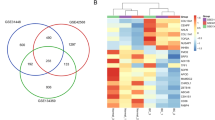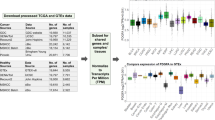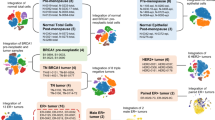Abstract
Identifying novel and known genes that are differentially expressed in breast cancer has important implications in understanding the biology of breast tumorigenesis and developing new diagnostic and therapeutic agents. In this study we have combined two powerful technologies, PCR-based cDNA subtraction and cDNA microarray, as a high throughput methodology designed to identify cDNA clones that are breast tumor- and tissue-specific and are overexpressed in breast tumors. Approximately 2000 cDNA clones generated from the subtracted breast tumor library were arrayed on the microarray chips. The arrayed target cDNAs were then hybridized with 30 pairs of fluorescent-labeled cDNA probes generated from breast tumors and normal tissues to determine the tissue distribution and tumor specificity. cDNA clones showing overexpression in breast tumors by microarray were further analysed by DNA sequencing, GenBank and EST database searches, and quantitative real time PCR. We identified several known genes, including mammaglobin, cytokeratin 19, fibronectin, and hair-specific type II keratin, which have previously been shown to be overexpressed in breast tumors and may play an important role in the malignance of breast. We also discovered B726P which appears to be an isoform of NY-BR-1, a breast tissue-specific gene. Two additional clones discovered, B709P and GABAA receptor π subunit, were not previously described for their overexpression profile in breast tumors. Thus, combining PCR-based cDNA subtraction and cDNA microarray allowed for an efficient way to identify and validate genes with elevated mRNA expression levels in breast cancer that may potentially be involved in breast cancer progression. These differentially expressed genes may be of potential utility as therapeutic and diagnostic targets for breast cancer.
This is a preview of subscription content, access via your institution
Access options
Subscribe to this journal
Receive 50 print issues and online access
$259.00 per year
only $5.18 per issue
Buy this article
- Purchase on Springer Link
- Instant access to full article PDF
Prices may be subject to local taxes which are calculated during checkout




Similar content being viewed by others
Abbreviations
- EST:
-
expressed sequence tag
- GABAπ:
-
γ-aminobutyrate type A receptor π subunit
- ORF:
-
open reading frame
- PBMC:
-
peripheral blood mononuclear cells
- PCR:
-
polymerase chain reaction
- RT:
-
reverse transcription
- SSH:
-
suppression subtractive hybridization
References
Amenta F, Cavallotti C, Ferrante F, Erdo SL . 1988 Pharmacol. Res. Commun. 20: 863–868
Apostolopoulos V, McKenzie IFC, Pietersz GA . 1996 Cell Biol. 74: 457–464
Bakker AB, Schreurs MW, de Boer AJ, Kawakami Y, Rosenberg SA, Adema GJ, Figdor CG . 1994 J. Exp. Med. 179: 1005–1009
Bertin N, Clezardin P, Kubiak R, Frappart L . 1997 Cancer Res. 57: 396–399
Bosher JM, Williams T, Hurst HC . 1995 Proc. Natl. Acad. Sci. USA 92: 744–747
Bowden PE, Hainey SD, Parker G, Jones DO, Zimonjic D, Popescu N, Hodgins MB . 1998 J. Invest. Dermatol. 110: 158–164
Cheever MA, Disis ML, Bernhard H, Gralow JR, Hand SL, Huseby ES, Qin HL, Takahashi M, Chen W . 1995 Immunol. Rev. 145: 33–59
Colpitts TL, Billing-Medel P, Friedman P, Granados EN, Hayden M, Hodges S, Menhart N, Roberts L, Russell J, Stroupe SD . 2001 Biochemistry 40: 11048–11059
Coulie PG, Brichard V, Van PA, Wolfel T, Schneider J, Traversari C, Mattei S, De PE, Lurquin C, Szikora JP . 1994 J. Exp. Med. 180: 35–42
Cox AL, Skipper J, Chen Y, Henderson RA, Darrow TL, Shabanowitz J, Engelhard VH, Hunt DF, Slingluff CLJ . 1994 Science 264: 716–719
DeRisi JL, Iyer VR, Brown PO . 1997 Science 278: 680–686
Diatchenko L, Lau YC, Campbell AP, Chenchik A, Moqadam F, Huang B, Lukyanov S, Lukyanov K, Gurskaya N, Sverdlov ED, Siebert PD . 1996 Proc. Natl. Acad. Sci. USA 93: 6025–6030
Disis ML, Cheever MA . 1997 Adv. Cancer Res. 65: 343–371
Erdo SL, Mione MC, Amenta F, Wolff JR . 1989 Br. J. Pharmacol. 96: 313–318
Fleming TP, Watson MA . 2000 Ann. N.Y. Acad. Sci. 923: 78–89
Hadden JW . 1999 Int. J. Immunopharmacol. 21: 79–101
Hedblom E, Kirkness EF . 1997 J. Biol. Chem. 272: 15346–15350
Hoch RV, Thompson DA, Baker RJ, Weigel RJ . 1999 Int. J. Cancer 84: 122–128
Houghton RL, Dillon DC, Molesh DA, Zehentner BK, Xu J, Jiang J, Schmidt C, Frudakis A, Repasky E, Filho A, Nolasco M, Badaro R, Zhang X, Roche PC, Persing DH, Reed SG . 2001 Mol. Diag. 6: 79–91
Jager D, Stockert E, Gure AO, Scanlan MJ, Karbach J, Jager E, Knuth A, Old LJ, Chen YT . 2001 Cancer Res. 61: 2055–2061
Jones KA, Brown MA, Solomon E . 1995 Cancer. Surv. 25: 315–334
Kawakami Y, Eliyahu S, Delgado CH, Robbins PF, Sakaguchi K, Appella E, Yannelli JR, Adema GJ, Miki T, Rosenberg SA . 1994 Proc. Natl. Acad. Sci. USA 91: 6458–6462
Kurebayashi J, Otsuki T, Kunisue H, Tanaka K, Yamamoto S, Sonoo H . 2000 Clin. Cancer Res. 6: 512–518
Lopez-Otin C, Diamandis EP . 1998 Endo. Rev. 19: 365–396
Loridon-Rosa B, Vielh P, Matsuura H, Clausen H, Cuadrado C, Burtin P . 1990 Cancer Res. 50: 1608–1612
Majewska MD, Vaupel DB . 1991 J. Endocrinol. 131: 427–434
McKenzie IF, Xing PX . 1990 Cancer Cells 2: 75–80
Nakai K, Horton P . 1999 Trends Biochem. Sci. 24: 34–36
Ozturk M, Ponchel F, Puisieux A . 1992 Bone Marrow Trans. 1: 164–170
Regnier CH, Boulay A, Asch PH, Wendling C, Chenard MP, Tomasetto C, Rio MC . 1998 Br. J. Cancer 78: 1640–1644
Schena M, Shalon D, Davis RW, Brown PO . 1995 Science 270: 467–470
Schena M, Shalon D, Heller R, Chai A, Brown PO, Davis RW . 1996 Proc. Natl. Acad. Sci. USA 93: 10614–10619
Trask D, Band V, Zajchowski DA, Yaswen P, Suh T, Sager R . 1990 Proc. Natl. Acad. Sci. USA 87: 2319–2323
Turner BC, Zhang J, Gumbs AA, Maher MG, Kaplan L, Carter D, Glazer PM, Hurst HC, Haffty BG, Williams T . 1998 Cancer Res. 58: 5466–5472
Walker RA, Jones JL, Chappell S, Walsh T, Shaw JA . 1997 Cancer Metast. Rev. 16: 5–27
Watson MA, Fleming TP . 1996 Cancer Res. 56: 860–865
Watson MA, Dintzis S, Darrow CM, Voss LE, DiPersio J, Jensen R, Fleming TP . 1999 Cancer Res. 59: 3028–3031
Xu J, Stolk JA, Zhang X, Silva SJ, Houghton RL, Matsumura M, Vedvick TS, Leslie KB, Badaro R, Reed SG . 2000 Cancer Res. 60: 1677–1682
Acknowledgements
We thank Incyte Pharmaceutical Inc. for their help in microarray technology. Some tissue samples were obtained from the Cooperative Human Tissue Network, which is funded by the National Cancer Institute, and from National Disease Research Interchange. This work was supported in part by the NIH grant CA75794 (RL Houghton).
Author information
Authors and Affiliations
Corresponding author
Rights and permissions
About this article
Cite this article
Jiang, Y., Harlocker, S., Molesh, D. et al. Discovery of differentially expressed genes in human breast cancer using subtracted cDNA libraries and cDNA microarrays. Oncogene 21, 2270–2282 (2002). https://doi.org/10.1038/sj.onc.1205278
Received:
Revised:
Accepted:
Published:
Issue Date:
DOI: https://doi.org/10.1038/sj.onc.1205278
Keywords
This article is cited by
-
In silico SNP analysis of the breast cancer antigen NY-BR-1
BMC Cancer (2016)
-
A Novel mRNA Level Subtraction Method for Quick Identification of Target-Orientated Uniquely Expressed Genes Between Peanut Immature Pod and Leaf
Biological Procedures Online (2010)
-
GABA Receptor Expression in Benign and Malignant Thyroid Tumors
Pathology & Oncology Research (2009)
-
Tumor-Derived Fibronectin Is Involved in Melanoma Cell Invasion and Regulated by V600E B-Raf Signaling Pathway
Journal of Investigative Dermatology (2007)
-
Bioinformatic screening of human ESTs for differentially expressed genes in normal and tumor tissues
BMC Genomics (2006)



